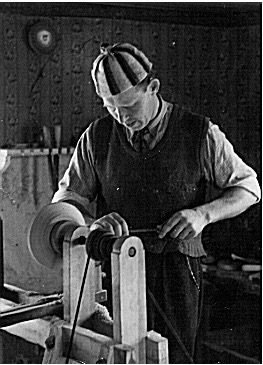Life in Sweden. 1944-1950.
We were well received in Sweden when our fishing boat arrived in Flen, a town north of Visby. The authorities were well organized to deal with refugees arriving from Latvia and Estonia and I suppose also some from Lithuania. We were showered and disenfected, given new clothing and were in quaranteen for a while. The Swedish government had a program of placing newcomers with families in various parts of the country. The families provided meals and accommodation and were paid by the government. A number of families were placed in close proximity so that there was a small community for mutual support. We were placed in Borgholm on the island of Øland in a lovely old two storey house. The stair up opened up into a living room off which were bedrooms. We had the whole second floor. We ate meals with the landlord's family and were invited to participate in their activities. Borgholm has a very large ruin of a Medieval castle, which I often went to explore. It was very impressive, with large corner towers and very spacious courtyard.
Borgholm castle ruins.
Courtyard.
View from harbour.
We attended Swedish language lessons and tried to integrate into our new homeland. My time in Borgholm is full of happy memories.There was a group of about a dozen men who were used to being constructively active and who now had nothing to do. My father, who was used to take charge, proposed that they set up a wood turning shop. To do this they needed tools. A blacksmith, with a stock of old files was found and my father, and a few others, created various wood turning chisels, straight ones, angled ones and curved ones in various sizes. Apple and pear wood was found and soon beautiful plates and bowls were being produced by the group. Some, like my father, chose to engrave these with intricate patterns, based on Latvian ornaments.
Arvids in action.
At some point the Swedish government placed individuals in various work positions compatible with their education, experience and talents. My dad was offered a position in the Chief Architect's office of the local district of Jønkøping, a town on lake Vättern in the southern part of Sweden. My father who had an Architect's degree from the University of Latvia, fitted in very well and was able to contribute to many architectural design and construction projects. He stayed in this position until we left for Canada in 1950. As usual, father always had to be building things. Jønkøping is surrounded by three lakes, so he decided to build a boat.
Arvids was also a very good self-taught artist and was able to develop his talent while living in Sweden and later in Canada. He was quite accomplished and exhibited at a number of juried exhibitions.
Life in Sweden was very comfortable, however my parents yearned for a more challenging and creative life. The state took care of everything, however there was little opportunity for entrepreneurship unless you were from one of the old Swedish families and well connected. My parents had investigated several possibilities and South Africa and Canada were being seriously considered. Canada and Toronto were finally chosen, mainly because there was a growing community of Latvian immigrants from Sweden. In May of 1950 we boarded the ship Gripsholm and arrived in Halifax at Pier 21.









